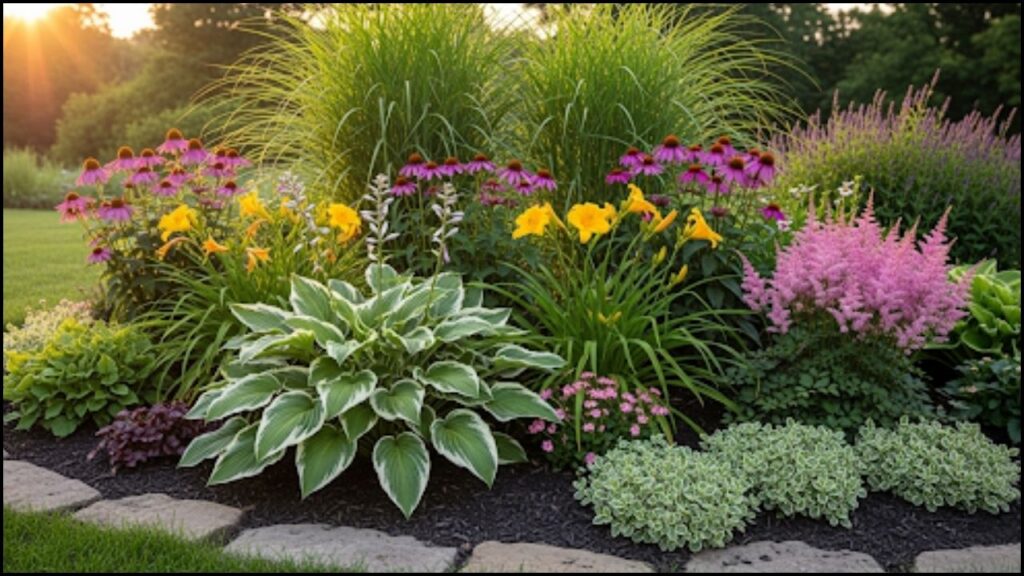Creating a visually stunning garden involves more than just selecting beautiful plants; it requires strategic placement. Learning how to arrange plants for a balanced garden by applying fundamental design principles can transform a chaotic collection of specimens into a cohesive and harmonious landscape, elevating its appeal from a simple hobby to a sophisticated design.

How to Arrange Plants for a Balanced Garden
| Design Principle | Detail | Why It Matters |
| Repetition | Repeating specific plants, colors, or forms throughout the garden. | Creates a sense of rhythm, unity, and visual flow, guiding the eye through the space. |
| Contrast | Juxtaposing different elements like textures, shapes, and colors. | Generates visual interest and prevents monotony. For example, placing fine-textured ferns next to bold-leafed hostas. |
| Scale & Proportion | Ensuring plant sizes are appropriate for each other and the surrounding space. | Prevents large plants from overwhelming small ones and ensures the garden feels right-sized for its environment. |
| Layering | Arranging plants in tiers, with tall plants in the back and shorter ones in front. | Creates depth, hides plant bases, and ensures all plants are visible and receive adequate light. |
The Foundation: Core Principles of Plant Composition
Achieving a professional-looking garden rests on timeless artistic principles. Landscape architects and master gardeners utilize concepts of repetition, contrast, and scale to create landscapes that feel both intentional and natural. Applying these strategies can help any gardener move beyond simply filling space.
“A common mistake is the ‘one-of-everything’ approach,” said Dr. Alena Vasquez, a professor of landscape architecture at the University of Illinois Urbana-Champaign, in a recent university publication. “While enthusiasm is wonderful, it leads to a garden that feels restless and disjointed. The key is to create unity.”
Repetition and Rhythm: Creating Cohesion
Repetition is the practice of using the same plant, or plants with similar characteristics, in multiple locations within a garden bed or across the entire landscape. This technique is fundamental to creating a unified look. According to a guide from the Cornell University Cooperative Extension, repeating elements like a specific variety of ornamental grass or a particular color of coneflower creates a visual pathway, leading the eye smoothly through the garden.
Experts often advise planting in odd numbers—groups of three, five, or seven—as this tends to appear more natural and less rigid than even-numbered groupings. This approach to plant composition prevents the “polka dot” effect of single, isolated specimens and establishes a stronger visual statement.
Contrast and Harmony: The Role of Texture, Form, and Color
While repetition creates unity, contrast generates excitement and focus. Contrast can be achieved through several elements:
- Texture: Combining plants with different leaf textures, such as the glossy, broad leaves of a hosta against the delicate, feathery fronds of an astilbe. This adds depth and tactile interest.
- Form: Placing plants with different shapes next to each other, such as a tall, spiky iris alongside a mounded geranium. Common forms include upright, weeping, rounded, and spreading.
- Color: Using colors opposite each other on the color wheel (e.g., purple and yellow) to create vibrant, energetic combinations. Alternatively, using analogous colors (neighbors on the color wheel, like blue and violet) can create a more serene, harmonious feel.
“Contrast makes a garden interesting in all four seasons,” explains David Chen, a senior horticulturist at the Atlanta Botanical Garden. “Even when flowers fade, the contrast between a plant’s form and leaf texture remains, providing a strong structural backbone.”
Practical Application: Layering for Depth and Interest
One of the most effective techniques to arrange plants for a balanced garden is layering. This involves organizing plants by their mature height and width to create a multi-tiered composition that adds visual depth and dimension.
Landscape Layering: Background, Midground, and Foreground
A well-structured garden bed is typically composed of three main layers:
- Background (The ‘Bones’): This layer consists of the tallest plants, such as evergreen shrubs, tall ornamental grasses, or climbing vines on a trellis. It forms the backdrop for the entire design and often provides year-round structure.
- Midground (The ‘Body’): This middle layer is filled with medium-sized perennials and smaller shrubs. These are often the show-stopping flowers and foliage that provide the bulk of the seasonal color and interest.
- Foreground (The ‘Edge’): This front layer includes low-growing perennials, annuals, and groundcovers. These plants soften the edges of pathways and beds, suppress weeds, and provide a welcoming entry point for the viewer’s eye.
This landscape layering strategy ensures that all plants are visible and that the composition has a clear and pleasing structure, similar to how a painter composes a landscape on canvas.
Scale and Proportion: Getting the Size Right
The principle of scale refers to the size of plants relative to one another and to the surrounding structures, such as a house or a walkway. Planting a very large, overpowering shrub next to a small, delicate perennial can create an awkward imbalance. “You have to consider the plant’s mature size, not what it looks like in the pot at the nursery,” Chen advises. “A good design accounts for growth over several years. This prevents overcrowding and ensures the intended balance of the design is maintained over time.”
Proportion extends this concept to the entire garden space. A massive, multi-tiered border might look out of place in a small urban courtyard, while a tiny flower bed could get lost next to a large home. Matching the scale of your plantings to the scale of your environment is crucial for a harmonious final look. The journey to a well-designed garden is ongoing. Plants grow and seasons change, offering new opportunities to refine and adjust the composition. By starting with these foundational garden design principles, gardeners can create a space that is not only beautiful but also visually balanced and deeply satisfying for years to come.
From Turf to Blooms: 9 Creative Front Yard Garden Ideas to Boost Curb Appeal and Biodiversity
